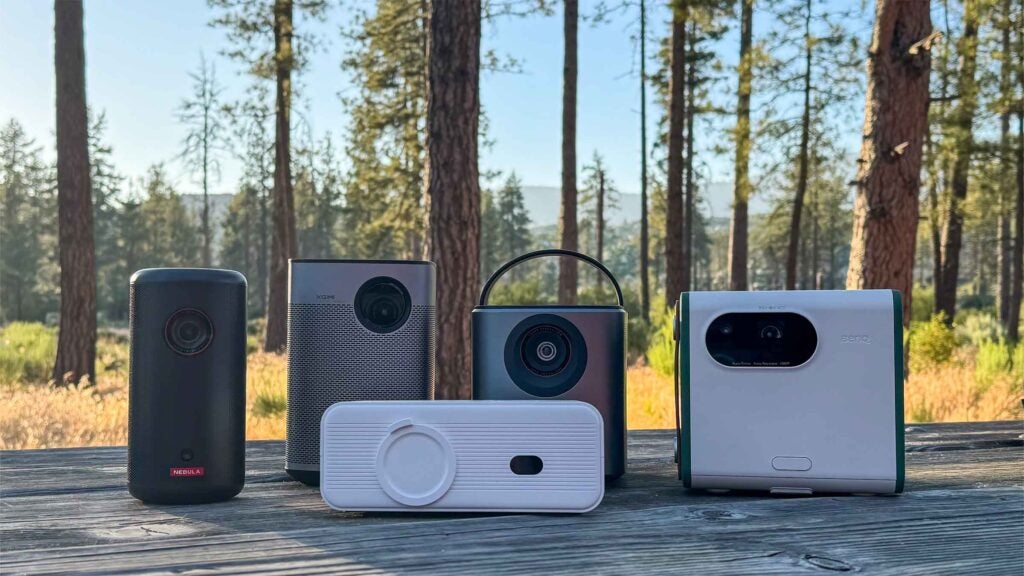No products in the cart.
Outdoor Adventure
The Best Projectors and Accessories (2024)
It’s hard to beat old-school summer camping: —s’mores over the campfire, fireside chats, and the Milky Way overhead. But from time to time it’s nice to bring in a little luxury. Enter the outdoor movie night. Whether you’re setting up at a traditional camping site, in your backyard, or on the side of a tricked-out van in the middle of the desert, these projectors and accessories offer a seamless blend between next-level theater entertainment and the great outdoors.
Over the past month, we tested a handful of projectors and accessories while camping from my van, from a tent, and in a controlled, indoor space to find the best combinations of value, picture quality, sound, durability, portability, and ease of use. Below you’ll find four projectors that performed the best, along with the best accessories to go with them.
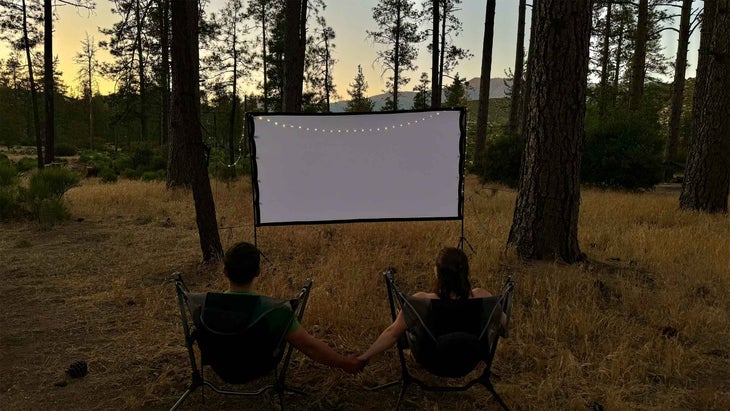
At a Glance
If you buy through our links, we may earn an affiliate commission. This supports our mission to get more people active and outside. Learn more.

Best Overall
XGIMI Halo+
Pros and Cons
⊕ Adjustable angle
⊕ Good autofocus and keystone correction
⊕ High-quality image and sound
⊗ Battery life isn’t great and is hard to measure
⊗ No handle or carry features
⊗ Expensive
XGIMI’s Halo+ stood out thanks to its brightness capability of 700 ISO lumens and quality color and contrast settings. While plugged into a power source, the Halo+ offered the most vivid and detailed picture of all the projectors we tested and allowed us to adjust the picture settings to our needs. When on battery power, the image was notably dimmer but kept the vivid color and sharp lines.
Out of the box, the projector set up easily with Android TV (though it did take a few more minutes with an iPhone rather than Android) and adjusted to whatever platform we projected onto (like a screen, sheet, wall, or van) thanks to its auto focus and keystone correction. Along with the Android TV, it offers other ways to project content including HDMI, Chromecast, and Bluetooth screen mirroring.
On the downside, the Android TV does not directly support Netflix, so to access that platform you’ll need to use an app workaround or HDMI cable. Plus, the Halo+ was the only projector that struggled to hold a charge for a full-length film, so having an extension cord and power source available would ensure an uninterrupted experience.
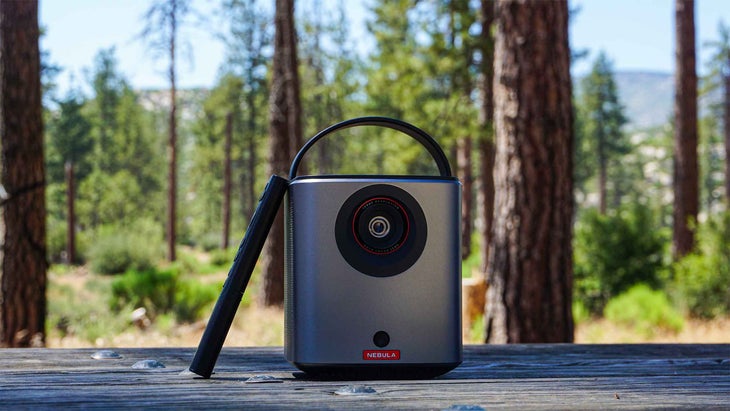
Best for Netflix-Lovers
Nebula Mars 3 Air GTV Projector
Pros and Cons
⊕ Charges quickly
⊕ Easy-to-read battery meter
⊕ Responsive remote
⊕ Exceptional internal sound
⊕ Netflix licensed
⊗ Auto keystone correction hurts more than helps the display
The Mars 3 Air GTV projector is the dream for anyone who primarily uses Netflix while streaming. The Google TV projector has all your favorite streaming and game apps with built-in Netflix (which Android TVs do not always support) and has an easy-to-use, responsive remote with Google Assistant. The only challenge we found with the Mars 3 Air was the projector’s auto keystone correction, which regularly miscalculated, completely skewed the picture quality, and typically required manual setting. However, this issue was easily solved by switching off the auto keystone correction.
With that setting fixed, the rest of the experience was everything we could hope for, offering picture and audio quality that rivals the Halo+. Plus, the internal battery easily lasted the equivalent of a full movie (approximately six 20-minute episodes of Young Sheldon) and LED battery status lights on the top made it easy to know when we needed to recharge.
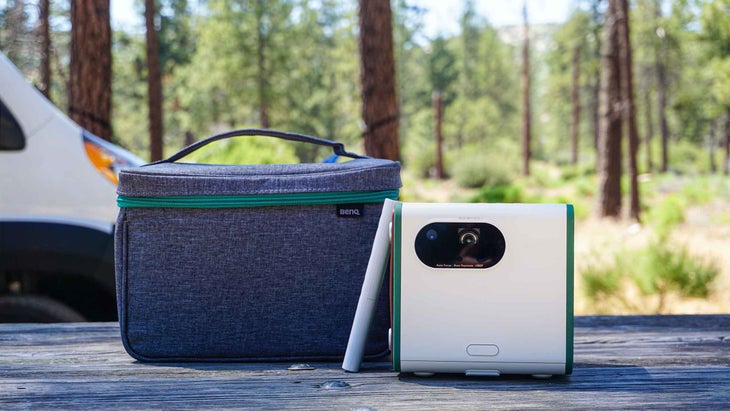
Most Camp-Friendly
BenQ GS50
Pros and Cons
⊕ Includes travel-friendly carry case
⊕ Splash and drop protections
⊗ Display isn’t as crisp or bright as some other projectors
⊗ Pricey
If you’ll be car camping or traveling, BenQ’s GS50 is the clear winner thanks to its impressive durability features and an included carrying bag. This sleek, eye-catching projector was the heaviest of the test, but it’s splash and drop-resistant and has plenty of internal battery for a full-length movie. We used it during a very misty evening in Fallbrook, California where everything got a little damp and, the projector had no issues.
Admittedly, while the brightness rating is 500 ANSI lumens (which is on par with the other projectors), we couldn’t get the GS50’s picture quality to be quite as crisp or vivid as others—though it was still plenty satisfactory.
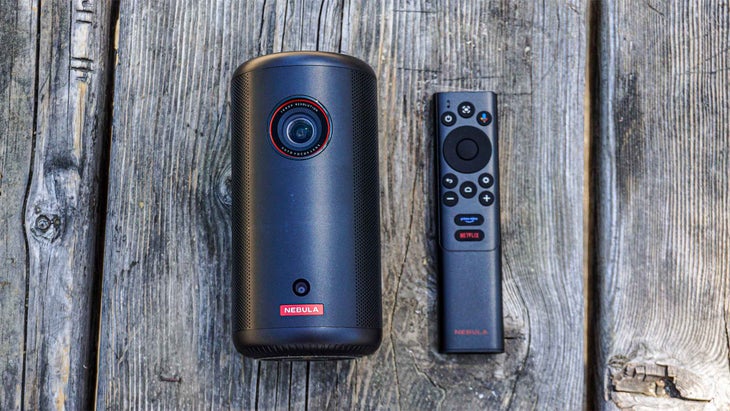
Most Compact
Nebula Capsule 3 GTV
Pros and Cons
⊕ Netflix licensed
⊕ Quality picture
⊕ Compact and portable
⊕ Easily charges with external battery through USB or USB-C
⊗ Slightly worse brightness capability than others
⊗ Auto keystone correction miscalculates
⊗ Set-up was challenging
The Capsule 3 GTV offers a superb combination of high-quality projection and compact portability. Smaller than a Nalgene bottle, the Capsule 3 GTV looks more like a portable Bluetooth speaker than it does a projector (in fact, it does have a Bluetooth speaker setting), but it packs a powerful punch with 200 ANSI lumens and crisp picture quality similar to the larger Mars 3 Air. The battery is meant to last a full 120 minutes, but even if you run low, the Capsule 3 GTV uses a USB-C to charge (instead of a proprietary mechanism), so you can easily use an external power bank for extra juice. Plus, the Google TV comes with built-in Netflix.
Unfortunately, the auto keystone correction was similar to the Mars 3 Air, which meant the picture would not accurately correct and we had to turn the feature off and manually set the frame. The system also required logging into a Google account before using most of the features, which proved challenging at the campsite.
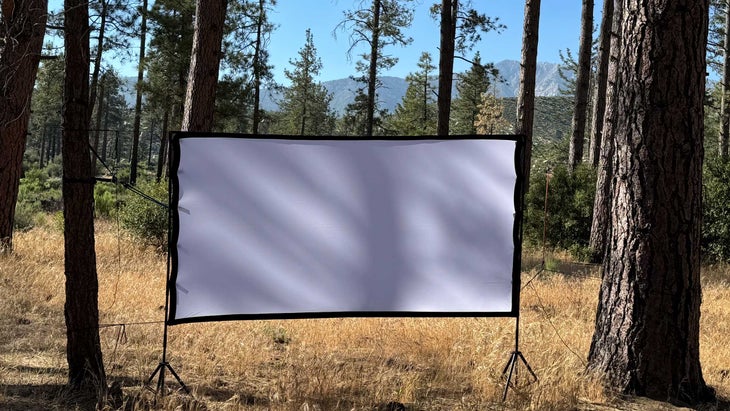
Best Stand-Alone Outdoor Screen
Towond 120 inch Portable Projector Screen
Pros and Cons
⊕ Stand-alone capability
⊕ Stake-down lines to combat wind
⊕ Relatively easy to set up and take down
⊗ Doesn’t stand up amazingly to stronger breezes
⊗ Set-up requires two people
For an outdoor screen that’s durable, affordable, portable, and easy to set up, the Towond Portable Projector Screen covers all the bases. The screen stand breaks down like tent poles and stores in a convenient carry bag with the wrinkle-free polyester screen material. Though we needed two people, the screen was easy to set up and take down thanks to a channel for the top crossbar and velcro straps that attach to the side poles for a smooth viewing platform.
Any stand-alone projector screen acts like a giant sail when any wayward breeze comes through, and the Towond was no exception. Even with stakes, tie-down lines, and weights on the tripod legs, the screen struggled to stay upright at a breezy campsite—though we were able to keep it steady by tying it between two trees.
Accessories
While not absolute necessities, a few additional tools may improve your outdoor movie experience.
- Queen Flat Sheet: If you don’t want to spend the money on a screen and don’t have a good platform like a van to project your film onto, you can always use a plain queen flat sheet you have in your house. We tested the Room Essentials Microfiber Queen Sheet set ($9.50) from Target, and found that though it was a little more wrinkled than the Towond screen, it did the trick. The main downfall with this option is since the sheet is not explicitly meant for this purpose, you may have to improvise some clips, magnets, and string to rig it up.
- A tripod or projector stand: In a pinch, you can adjust your projector angle and position with some strategic books, rocks, or other wedge-type space holders, but a stand will ensure you get the best projector positioning every time. All the projectors on this list have a screw-in attachment that’s compatible with a standard camera tripod or projector stand. For this testing, I used a Joby GorillaPod 1K Kit ($60), which struggled with the extra 1.4 pounds of the BenQ GS50, but otherwise did the trick.
- Bluetooth speaker: The projector speakers worked well enough on their own for small groups, but if you’re screening for a larger audience, a separate bluetooth speaker would be helpful. All the projectors above are Bluetooth compatible so you can connect your favorite Bluetooth speaker (or wireless headphones if it’s just you).
- Laptop: All the featured projectors have downloaded operating systems that act like any smart TV so all you really need to play content is an internet connection. However, if you’re off the grid, don’t forget to bring a laptop or other device with the downloaded movie.
Source link

